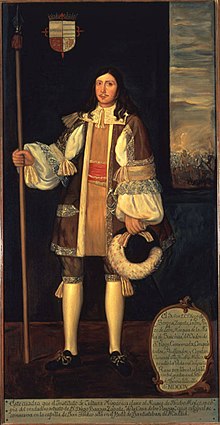

Diego de Vargas Zapata y Luján Ponce de León y Contreras
| |
|---|---|

Oil on canvas portrait of Diego de Vargas by Julio Barrera, date unknown, from the collection of the Palace of the Governors
| |
| 30 and 32nd Spanish Governor of New Mexico | |
| In office 1691 – 1697 (as effective) (titular 1688–91) | |
| Preceded by | Domingo Jironza Petriz de Cruzate |
| Succeeded by | Pedro Rodríguez Cubero |
| In office 1697–1703 | |
| Preceded by | Pedro Rodríguez Cubero |
| Succeeded by | Juan Páez Hurtado |
| Personal details | |
| Born | 1643 Madrid, Spain |
| Died | 1704 Bernalillo, Nuevo México (New Mexico) |
| Profession | Political and military |
| Signature |  |
| |
Diego de Vargas Zapata y Luján Ponce de León y Contreras (1643–1704), commonly known as Don Diego de Vargas, was a Spanish Governor of the New Spain territory of Santa Fe de Nuevo México (currently covering the modern US states of New Mexico and Arizona). He was the title-holder in 1690–1695, and effective governor in 1692–1696 and 1703–1704.[clarification needed] He is known for leading the reconquest of the territory in 1692 following the Pueblo Revolt of 1680. This reconquest is commemorated annually during the Fiestas de Santa Fe in the city of Santa Fe.
On 10 August 1680, Pueblo people from various pueblos in northern New Mexico staged an uprising against Spanish colonists.[1] They laid siege to the city of Santa Fe, forcing the colonists to retreat on 20 August. The Spanish colonists fled south to El Paso del Norte (now Ciudad Juárez, Mexico), where they remained in exile for the next 16 years.[2]
In 1688, Capitan General y Governador Don Diego de Vargas was appointed Spanish Governor of New Mexico, though he did not arrive to assume his duties until 22 February 1691.[3] He was assigned with the task of reconquering and pacifying the New Mexico territory for Spain. In July 1692, de Vargas and a small contingent of soldiers returned to Santa Fe. They surrounded the city and called on the Pueblo people to surrender, promising clemency if they would swear allegiance to the King of Spain (at the time, Charles II of Spain) and return to the Christian faith. After meeting with de Vargas, the Pueblo leaders agreed to surrender, and on 12 September 1692 de Vargas proclaimed a formal act of repossession. De Vargas’ repossession of New Mexico is often called a bloodless reconquest, since the territory was initially retaken without any use of force. However, according to historian Enrique Lamadrid, once Spanish law was reestablished in the region by 1693, 70 participants in the revolt were executed on the Santa Fe Plaza.[4][5]
De Vargas had prayed to the Virgin Mary, under her title La Conquistadora (Our Lady of Conquering Love), for the peaceful re-entry. Believing that she heard his prayer, he celebrated a feast in her honor. Today, this feast continues to be celebrated annually in Santa Fe as the Fiestas de Santa Fe. Part of those annual fiestas is a novena of masses in thanksgiving. Those masses are also done with processions from the Cathedral Basilica of St. Francis of Assisi to the Rosario Chapel. The actual statue of La Conquistadora is taken in the processions. After the novena is completed she is taken back to the Basilica. This event includes participation by local tribes as well as Latino descendants that reside in the area. In the second decade of the 21st century, members of Native American tribes and pueblos protested the pageant, recalling the subsequent retaking of Santa Fe.
The focus of these protests was The Entrada—a reenactment of de Vargas's re-entry into Santa Fe that has long been seen as inaccurate by historians and culturally offensive by Native Americans. The most recent round of protests against The Entrada started in 2015. That year, silent protestors raised placards citing historical facts at odds with the narrative present when the re-enactors reached Santa Fe's historic Plaza to portray the retaking of the city. Protests in 2017 resulted in 8 arrests; though the charges were later dismissed.[6][7][8] Following the protests and months of negotiation the Entrada was removed from The Santa Fe Fiesta celebration.[9]
On June 18, 2020 the city of Santa Fe, New Mexico removed a statue of Diego de Vargas.[10] The statue was one of several removed as wider efforts to remove controversial statues across the United States.
Like many wealthy citizens of the Spanish Empire at the time, de Vargas owned slaves. He manumitted his coachman Ignacio de la Cruz, but his wife Josefa de la Cruz (purchased in Mexico City in 1703 at age 20 for 300 reales de vellon) was part of the property of de Vargas' estate conveyed to other owners after his death. This is known from contemporary legal documents later collected by William Gillet Ritch.[11]
| International |
|
|---|---|
| National |
|
| Other |
|